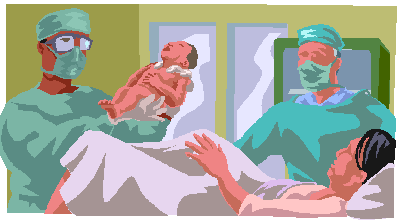|
Frequently Asked Questions: Plastic Surgery/Congenital Anomalies
|
|||
|
Congenital
Deformities "Congenital" conditions are those that are
present from birth. Conditions that begin after birth during a person's
lifetime are called "acquired" conditions.
Incidence: These deformities occur approximately once in every 500
births. There is a low risk of inheritance. The more severe types of
cleft seem to also have a higher risk. Development: In the early weeks of development (Before 12 weeks of
pregnancy), the right and left sides of the lip and the roof of the
mouth normally grow together. In about one of every 500
babies, those sections don't quite meet. A child born with a
separation in the upper lip is said to have a cleft lip. A similar birth
defect in the roof of the mouth, or palate, is called a cleft palate.
Since the lip and the palate develop separately, it is possible for a
child to have a cleft lip, a cleft palate, or variations of both.
When a cleft palate is present the baby is unable to
suck, but it is important to remember that it can swallow normally. Milk
is dribbled onto the back of the baby’s tongue through a large hole in
a large teat of a squeeze plastic bottle or by an eyedropper or with the
help of a spoon, keeping the child in little upright position to prevent
regurgitation through nose. Burping after each feed is extremely
important as these child swallow lot of air along with milk. Vaccination
should be carried out as per schedule. Team
Approach: Children born with a cleft lip or palate may need the
skills of several medical professionals to correct the problems
associated with the cleft. Typically, a Cleft Team consist of a plastic
surgeon (As Head of the team), a pediatrician, a dentist, a speech and
language specialist, a social worker, a hearing specialist, an
ear-nose-throat specialist, a psychologist, a nurse, and a genetic
counselor. Timing
of Surgery: Cleft
lip surgery is generally done when the child is about 10 weeks old.
Cleft palate repair require more extensive surgery and is usually done
when the child is nine to 18 months old, so the baby is bigger and
better able to tolerate surgery. Postoperative: By and large babies tolerate surgeries very well. They
are discharged generally from the hospital on 3rd or 4th
postoperative day. Hypospadias and other
Genito-urinary abnormalities Hypospadias occurs in approximately 1 in 300 male births.
Primary surgery is performed by a plastic surgeon between the age of 2
to 3 years. Efforts are made to complete in one stage but sometime more
than one surgery is required. All operations are completed before child
starts going to school. Other congenital abnormalities of the penis and
absence of the vagina are also treated by plastic surgeons.
Congenital deformities of the hand-that is, deformities a
child is born with-can interfere with proper hand growth and cause
significant problems in the use of the hand. Fortunately, with modern
surgical techniques most defects can be corrected at a very early age-in
some cases during infancy, in others at two or three years-allowing
normal development and functioning of the hand. Plastic surgeons can
usually restore comfort, mobility, and normal appearance to patients
with hand problems. Children born with syndactyly (webbed fingers) can
benefit from finger separation. If a child has a polydactyly (extra
fingers) or duplicate thumb, correction is often more than simply
removing the extra digits. The surgeon may also need to balance the
tendons of the hand and stabilize the remaining finger joints for better
hand function. Cranio facial defects This is a specialist area requiring the expertise of
plastic surgeons, neurosurgeons, oral and maxillofacial surgeons,
ophthalmologists, paediatricians and others.
|
||


 Cleft lip and Cleft
palate
Cleft lip and Cleft
palate Feeding
Advise:
Feeding
Advise: Congenital Hand
Defects
Congenital Hand
Defects